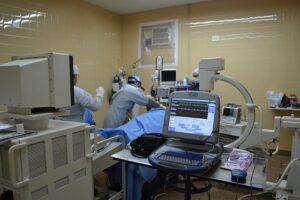ARDS: Identifying the Genetic Factors at Play
ARDS: Identifying the Genetic Factors at Play
Acute Respiratory Distress Syndrome (ARDS) is a life-threatening condition characterized by widespread inflammation in the lungs. This condition leads to substantial impairment in the exchange of oxygen and carbon dioxide, severely impacting organ function and risking mortality. Though ARDS affects many, its mechanisms—particularly those at the genetic level—remain relatively obscure. This article aims to shine a light on the genetic factors associated with ARDS, offering clarity for those impacted by this serious medical plight.
Understanding ARDS and Its Impact
ARDS is not a singular disease but a clinical syndrome that arises from various underlying etiologies, including pneumonia, sepsis, aspiration of gastric contents, and trauma. Patients afflicted by ARDS often present with acute onset of respiratory failure, requiring supplemental oxygen and, in severe cases, mechanical ventilation. The condition is marked by a high mortality rate, ranging between 30-50% in adults, making the identification of risk factors crucial for prevention and treatment strategies.
Initially described in the 1960s, the characterization of ARDS has evolved significantly. The Berlin Definition, established in 2012, classifies ARDS based on the degree of hypoxemia and timing of onset, thereby streamlining research and clinical approaches to the syndrome. A critical component of understanding ARDS involves investigating factors that predispose individuals to developing the condition, with genetics playing a pivotal role.
- ARDS arises from multiple causes, including infections, inhalation injuries, and systemic inflammation.
- Mortality rates for ARDS can be as high as 30-50%, necessitating effective strategies for early identification and intervention.
- The Berlin Definition offers a standardized framework for understanding and diagnosing ARDS.
Genetic Contributions to ARDS Vulnerability
While ARDS can manifest following various environmental and health triggers, research increasingly points to genetic predispositions that may heighten an individual’s risk. The human genome operates like an intricate blueprint, where specific genes can influence the body’s inflammatory responses, lung structural integrity, and overall susceptibility to infections. By identifying genetic factors linked to ARDS, we can develop targeted treatment approaches and preventive measures.
Studies have focused on the role of specific genes associated with the immune system, such as the following:
- Interleukin-6 (IL-6): A pro-inflammatory cytokine implicated in the inflammatory cascade post-injury.
- Tumor Necrosis Factor Alpha (TNFα): Another cytokine that can exacerbate inflammation and lung injury.
- Surfactant Protein Genes (SP-A, SP-B, SP-C): Essential for alveolar stability and function; mutations can impair lung function.
The influence of polymorphisms—variations in the DNA sequence—within these genes can modulate an individual’s inflammatory response severity, making genetic testing a potential tool for assessing ARDS risk. For example, some studies have linked specific IL-6 gene polymorphisms to an increased susceptibility to ARDS in critically ill patients, suggesting that a person’s genetic makeup can indeed alter their likelihood of experiencing this syndrome.
Genetic Markers and Phenotypic Expression
It is important to note that genetics alone do not determine the onset of ARDS. Phenotypic expression, which refers to how genetic predispositions manifest in observable traits, plays a crucial role. For example, an individual may carry genetic markers associated with a heightened risk of ARDS, but whether they ultimately develop the syndrome often depends on a combination of environmental triggers and pre-existing health conditions.
Key aspects of phenotypic expression in ARDS include:
- Age and Gender: Young males may have higher risk factors due to differences in lung development and inflammatory responses.
- Pre-existing Health Conditions: Conditions such as obesity, diabetes, and chronic bronchitis can increase susceptibility.
- Environmental Exposures: Occupational hazards, smoking, and air quality can trigger underlying genetic vulnerabilities.
Research has emphasized the significance of integrated genetic and phenotypic profiling in understanding ARDS. Genetic variations can manifest differently based on the interaction with the environment and overall health, further complicating efforts to devise tailored therapeutic interventions.
Family History and Genetic Counseling
Having a family history of respiratory illnesses can be an ominous sign for ARDS susceptibility. Given that many genetic factors influencing ARDS are inherited, individuals with a familial predisposition must remain vigilant for early signs and symptoms. Genetic counseling plays a pivotal role in educating families about their potential risk and in making informed decisions regarding health management.
Benefits of genetic counseling for ARDS include:
- Identifying Risk: Understanding familial patterns can prompt earlier and more aggressive interventions.
- Informed Decision-Making: Empowering patients to participate in preventive health care and lifestyle modifications.
- Research Participation: Encouraging families to partake in studies focused on ARDS genetics may yield valuable insights.
Advancements in Genomic Research
The research landscape for ARDS genetics is rapidly evolving, with next-generation sequencing technologies allowing scientists to explore the genome in unprecedented detail. This technological advancement has paved the way for large-scale genome-wide association studies (GWAS) that look for correlations between genetic variations and ARDS occurrence.
Key findings from recent genomic research include:
- Discovery of Novel Loci: Identification of new genetic loci associated with ARDS pathogenesis.
- Multi-omics Approaches: Integration of genomic, proteomic, and metabolomic data to create a comprehensive understanding of ARDS.
- Biomarker Development: Identifying relevant genetic and biochemical markers could lead to enhanced diagnostic capabilities and targeted therapies.
As research continues to expand, collaborative efforts among geneticists, pulmonologists, and epidemiologists are essential to unravel the complexities of ARDS and its genetic factors.
FAQs about ARDS and Genetics
To provide further clarity, here are some commonly asked questions regarding ARDS and its genetic components:
- What triggers ARDS? ARDS can be triggered by numerous factors, including infections (pneumonia, sepsis), trauma, inhalation of harmful substances, and excessive fluid accumulation in the lungs.
- Can ARDS be inherited? While not directly inherited, genetic factors may increase susceptibility based on familial patterns of respiratory illness.
- How can I reduce my risk of ARDS? Maintaining a healthy lifestyle, managing chronic diseases, avoiding smoking, and minimizing exposure to harmful substances can help reduce your risk.
- What role does inflammation play in ARDS? Inflammation is a primary pathway through which lung injury occurs in ARDS, exacerbating pulmonary edema and impairing oxygen transfer.
- Are there any genetic tests for ARDS? Currently, comprehensive genetic testing specifically for ARDS risk is limited, but advances in genomic research may pave the way for future screenings.
Conclusion
Understanding ARDS and its intricate relationship with genetic factors is essential for enhancing awareness and developing effective interventions. As emerging research continues to unveil the genetic underpinnings of ARDS, affected individuals and families can better navigate their health challenges. Those impacted by ARDS—both patients and their loved ones—should focus not just on the fear that often accompanies a diagnosis, but also on the knowledge and resources available to them. By promoting research and providing insights into the genetic influences on ARDS, we can aspire to cultivate deeper understanding and better outcomes for affected individuals.
References
For more information on ARDS and ongoing genetic research, consider exploring the following resources:
About ARDS and Post-ARDS
ARDS (Acute Respiratory Distress Syndrome) is a life-threatening condition typically treated in an Intensive Care Unit (ICU). While ARDS itself is addressed during the ICU stay, recovery doesn’t end with discharge; patients then embark on a journey of healing from the effects of having had ARDS.
Disclaimer
The information provided in ARDS Alliance articles is for general informational and educational purposes only and is not a substitute for professional medical advice, diagnosis, or treatment. While we strive to present accurate, current information, the field of Acute Respiratory Distress Syndrome (ARDS) and related healthcare practices evolve rapidly, and ARDS Alliance makes no guarantee regarding the completeness, reliability, or suitability of the content.
Always seek the advice of qualified healthcare professionals with any questions you may have regarding a medical condition. Never disregard professional medical advice or delay seeking it because of information you read in ARDS Alliance articles. ARDS Alliance, its authors, contributors, and partners are not liable for any decision made or action taken based on the information provided in these articles.
About ARDS Alliance
Our mission is to improve the quality of life for ALL those affected by ARDS.
The ARDS Alliance is a non-profit committed to raising awareness and enhancing the understanding of Acute Respiratory Distress Syndrome (ARDS), a severe lung condition often occurring in critically ill patients. Through developing alliances, it unites various organizations and experts striving to improve care and support research aimed at finding more effective treatments. Their efforts include educating the public and healthcare providers about ARDS symptoms, risk factors, and advancements in treatment, ensuring better patient outcomes and resource availability.

I am dedicated to advancing research and education about Acute Respiratory Distress Syndrome. Our mission is to improve outcomes for patients and their families by providing support and resources for healthcare professionals. Together, we can make a difference in the lives of those affected by ARDS.
~ Paula Blonski
President, ARDS Alliance





